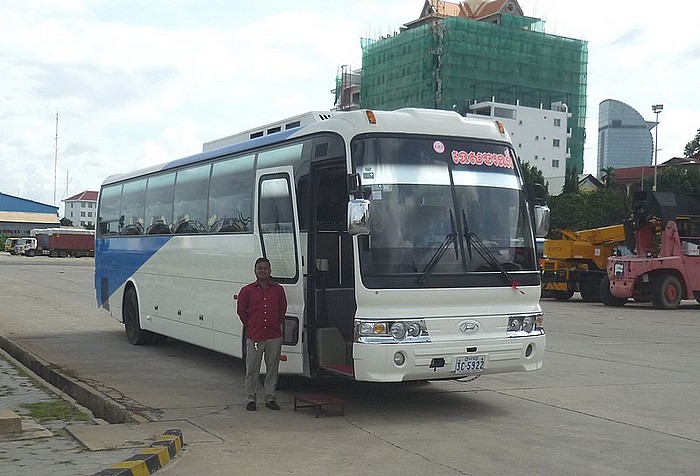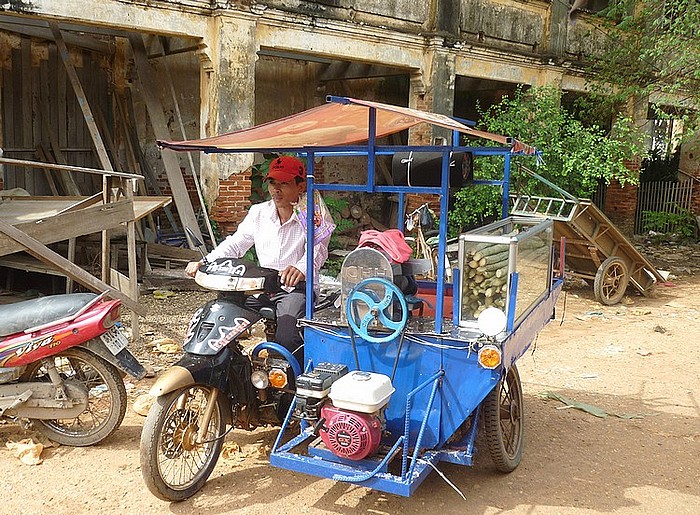

Transport in Cambodia (by Dick Gilbert)
The Classic British Isles Buses Website
Last updated 27 August 2024
Email Events diary Past events list Classified adverts Classic U.K. Buses Classic Irish Buses Classic Manx Buses
These pictures were taken during a delightful journey down the Mekong River from Siem Reap in Cambodia (home of the glorious Angkor Wat temple complex) to Saigon in Vietnam (officially called Ho Chi Minh City). Here are some snapshots of transport delights that I saw during the Cambodian part of the trip.
Two pages about the Vietnamese part of the story start here.
You can sum up the modern transport scene in Cambodia in one word - Hyundai. Yet there are interesting nuggets and surprises to be seen as well, although it's worth mentioning that the whole country was completely devastated by the Pol Pot regime in the late 1970s and hardly anything survives from before that. It's hard to describe the horrifying effect of that period for Cambodia and it's just amazing how peaceful and gentle the country and the people are today after an experience like that. I've tried to concentrate on things that were specific to Cambodia but a few familiar sights (mostly Hyundai) are inevitable.

As I mentioned above, most Cambodian buses are made by Hyundai. Seen here on the dockside at Phnom Penh is a Hyundai Aero that took us on a trip from our river boat. I think it has a Hi-Space body.

This is a Hyundai Universe heavy-duty luxury coach parked outside the Killing Fields Museum on the outskirts of Phnom Penh.

Here we see a typical Cambodian mid-size bus, the Hyundai County seen in Siem Reap.

Also seen at the Killing Fields Museum near Phnom Penh, and just to show that not every Cambodian bus is a Hyundai, this is a Kia Granbird Sunshine. The Granbird was derived from the Mitsubishi Fuso and this one is pretty new.

This bus has an Aero Hi-Class Express body which suggests it's a Hyundai but the logo is wrong. The trouble is that there are a lot of logos around that look like a stylised H - Hyundai, Honda, Higer, Hino, Acura etc. - and it's sometimes hard to tell one from another. Here's a closeup of that badge:

Looks to me like a Star Wars Tie Interceptor! However I'm convinced it's an alternative Hyundai logo, maybe one for vehicles built abroad under licence - I saw many more of these in Vietnam. Can anyone clarify the situation?

The Cambodian tuktuk is not like the ones seen in India and elsewhere. Unlike the typical tricycle Bajaj RE (although I did see a few of those in the capital Phnom Penh) in Cambodia they put a trailer on a motorbike, which means four wheels on their wagons. The Cambodian tuktuk can carry passengers or freight, and this one seen in Phnom Penh combines the tasks of being a taxi and a distinctive advertising facility.

Here's another typical Cambodian passenger tuktuk in Phnom Penh. They are great fun to travel in, and cheap as chips to hire.

Here is the freight version of the Cambodian tuktuk seen in Siem Reap, in this case carrying wood. In the background is an Isuzu truck - they turn up everywhere I have travelled, so presumably they are darned good products!

Here is another freight Cambodian tuktuk seen in Siem Reap, but this is a tricycle. I love this guy's T-shirt - the biggest pair of sunglasses in the world. It says LIMHUY on the petrol tank, but I think this is the owner's name (or maybe a local dealer) rather than the make of vehicle. Anyone know the answer?

Tuktuks can be as long as you like. This one is near Wat Hanchey in southern Cambodia. Who'd have thought that a motorbike would pull something as big as this?

And here's another way to haul timber with a motorbike. It looks like a custom-made piece of kit and is seen in the rural village of Chloung in south eastern Cambodia, renowned for its French colonial buildings.

Or, as seen here in Phnom Penh, you just get the wife to carry the wood. By the way a motorbike in Cambodia is called a moto and a tricycle pedal rickshaw is called a cyclo.

Here's a cyclo in Phnom Penh. The driver pedals from the back while the passenger sits in the front facing forwards. There are also ox carts in Cambodia, but these days they are mostly only for tourists. I rode in one, and can assure you that it is not comfortable!

Of course if you add a sidecar to a moto then a whole lot of new opportunities open up. This guy is running a mobile sugar-cane juicing shop in Chloung.

Let's crank up the scale a bit. This style of tractor was very common in rural areas, and they all seemed to be based on Kubota engines made in Thailand (Siam Kubota). In this case, seen in Angkor Ban, its a Kubota RT120 (12 horsepower), near the top of the range of motors which start with the RT80 (8 horsepower) and work up to the RT140 (14 horsepower).

The next size up is this little truck, of which we saw quite a few in the countryside - this is in Chloung. Now the identification of these agricultural vehicles is not easy, but this one definitely had a Hyundai badge on the steering wheel. I'm sure this model has a name or number but I've no idea what it is, and I've never seen trucks quite like them anywhere else on my travels. Let's look at some more.

Slightly bigger is this typical agricultural tipper truck. Is it a Hyundai or a Mitsubishi? Or something else? It didn't help that I saw one of them wearing a fake Nexus badge!

Here's a larger one in its natural environment - the fields and tracks of rural Cambodia. I'm 90% sure that this is a Mitsubishi. Can anyone provide more details about these vehicles?

And here's an even bigger one, with three axles. This one definitely has a Mitsubishi badge on the front but I can't find it anywhere in their product range, and it also has the upswept wing shape on the grille, just like the example shown three photos above which has a Hyundai steering wheel! So how do you explain that?

This one is something else again. It's definitely a Hyundai (it's got it written above the grille, although it also has a Honda logo on the seat just below the headrest!) and is almost certainly used for logging, which explains the winch and the cut-out at the front of the truck body. It's in Chloung in south east Cambodia.

Talking of logging, now here's something really intriguing. I believe this to be an old M-series US army truck left over from the Vietnam war and converted for use as a heavy duty logger (I'm sure there's an expert out there who will tell me if I'm talking rubbish). We went into one village in southern Cambodia which had at least a dozen of these and maybe as many as twenty in various states of repair.

Here's another of the ex US Army trucks, if indeed that's what they were. We saw them all in the riverside village of Kratie in central Cambodia. I understand that most of the logging in the area was illegal deforestation and the government has allegedly put a stop to it. But, despite that claim, some of these trucks looked as though they were still in regular use....

Let's return to conventional transport (and back to the inevitable Hyundai) and this seems to be a Hyundai H-100 light van, possibly for live poultry transport. Unfortunately it also seems to have had a bad day. Among other smaller trucks and vans we saw Toyota, UD, Nissan, Lexus, Fuso and Isuzu - all from Japan - along with Ford, Mercedes, Daewoo, the inevitable Ssangyong Istana Super Prime and even a few Land Rovers.

This is a Hyundai Cargo 3-axle truck, either the 8.5 or 9 ton version, probably from the mid 1990s. As well as Hyundai trucks I saw smaller numbers of Mitsubishi Fuso, Hino, Mercedes, ASIA (which I think is part of Kia) from Korea, plus Kamaz from Russia and, from China, DongFeng, Chenglong and (surprisingly) some abandoned Shacman tippers in a poor state.

Bigger still is this magnificent 5-axle Hyundai 19.5 ton truck.

Finally, because I can't resist a bit of aviation, here are a couple of Airbus A320s at Siem Reap airport. This one is XU-701 from Sky Angkor Airlines, viewed past the colourful winglet another A320, Thai Smile HS-TXS which had flown us in from Bangkok.

And this Airbus A320 is A5-RGG from Royal Bhutan Airlines / Drukair. That's it folks. We then moved on down the Mekong river to Vietnam, and the Vietnamese part of the story starts here.
Email Events diary Past events list Classified adverts Classic U.K. Buses Classic Irish Buses Classic Manx Buses